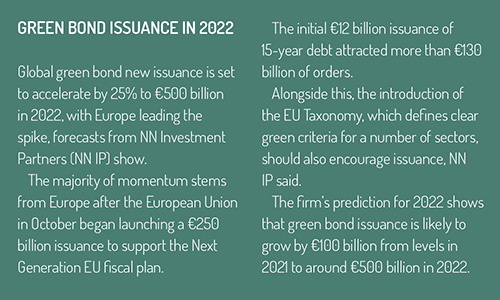In 2020, Paris-based stock exchange operator Euronext listed 37 green bonds. These bonds form a ‘green revolution’ with deep roots in France, as Lynn Strongin Dodds reports.
Although sustainable bonds are on the agenda of many European asset managers today, they are not a new phenomenon to the French industry. Kickstarted in 2012, the country boasts one of the earliest domestic green bond markets, while French authorities have been at the forefront in pushing fund managers into greening their portfolios.
“France in particular, and the EU in general, have been leading the way in the issuance of ESG [environmental, social and governance] bonds, including green bonds, thanks to the early support of the French state, a pioneering role in the fight against climate change, and the support of the broader ecosystem,” says Anthony Attia, global head of primary markets and post-trade at Euronext, the Paris-based stock exchange operator.
As of March 21, research from Bloomberg shows that the country was the world’s biggest sovereign issuer of green bonds, at $40 billion (€34 billion). After France, Germany was in second place with $13.6 billion, followed by the Netherlands at $12.5 billion.
French issuance began with the Green OAT sale, issued by Agence France Trésor, which manages state debt and was the first sovereign issuer of a benchmark-size green bond in 2017. In 2021, a further issuance was almost five times oversubscribed, with around €4 billion of the €7 billion issuance allocated to green investors.
France cut its teeth almost a decade ago when three local authorities tapped the market to fund a variety of green projects. Although local and national governments continue be active, financial institutions have recently joined the fray to transition to a more sustainable environment.
In April, major French banks joined the Net Zero Banking Alliance, a UN-backed initiative committing global banks with more than $30 trillion in assets to align with keeping global warming to well below 2°C.
“One of the key reasons French banks are active is that they are committed to net-zero targets and are aiming their loan portfolio to sustainable projects such as renewable energy and green buildings,” says Romain Miginiac, portfolio manager of the GAM Sustainable Climate Bond fund and head of research at Atlanticomnium, a firm that manages the fund. “Issuing green bonds is also an effective way for banks to match their green assets with liabilities.”
However, the real trigger can be traced back to the Paris Climate Agreement in 2015, “COP21 was a real turning point in France, and I think is one of the main reasons why the country is ahead of the queue,” says Johann Plé, green bonds strategy manager at Axa Investment Managers, which was one of the first signatories of the UN Principles of Responsible Investment in 2007. “The French government has since tried to encourage institutional investors to have more transparency around ESG metrics and climate impact. “
ESG is a “given”
Arnaud-Guilhem Lamy, head of euro multi-strategy fixed income at BNP Paribas Asset Management (BNPP AM), echoes these sentiments. “ESG is more or less a given in France,” he says. “We have had the SRI [socially responsible investment] label for years and I think that has been a strong positive. It has pushed asset managers because if you do not integrate ESG into the process then you cannot sell into France.”
 The SRI labelling system came into force in 2016 and is continually updated. It imposes a set of rigorous criteria for fund managers to demonstrate the systematic and measurable integration of extra-financial and ESG analysis into investments. The government also won high praise for Article 173 of the Energy Transition for Green Growth Law launched right after COP21. It has been described as ground-breaking and an inspiration for the European Union’s Sustainable Finance Disclosure Regulation (SFDR), which came into effect in March 2021 to establish a common standard for reporting on financial products in European countries.
The SRI labelling system came into force in 2016 and is continually updated. It imposes a set of rigorous criteria for fund managers to demonstrate the systematic and measurable integration of extra-financial and ESG analysis into investments. The government also won high praise for Article 173 of the Energy Transition for Green Growth Law launched right after COP21. It has been described as ground-breaking and an inspiration for the European Union’s Sustainable Finance Disclosure Regulation (SFDR), which came into effect in March 2021 to establish a common standard for reporting on financial products in European countries.
In the past two years, the Autorité des Marchés Financiers (AMF), France’s financial regulator, has stepped up its ESG pressure. It not only encouraged greater shareholder engagement but also introduced a Transparency Code document, to be made available to the public, that clearly defines each fund’s ESG methodology.
In addition, the AMF adopted a tougher stance than the SFDR. Its recently published Doctrine obliges green products to satisfy minimum investment criteria (i.e. a certain percentage of a fund’s assets have to be invested in line with the non-financial strategy that is promoted by the fund); Articles 8 and 9 of SFDR contain no such requirement and allow for managers to run blended portfolios.
Investment professionals will also be put through their paces with a new sustainable finance certification effective at the end of the year. It will include an examination consisting of 60 questions, covering sustainable finance terminology and the surrounding ecosystem, which includes the French and European regulatory framework, ESG issues, non-financial asset management approaches, and the marketing of sustainable investment products.
Many French institutions already have well-established frameworks in place to integrate the sustainability agenda in their investment strategies, while French asset managers such as Amundi, Axa, BNP Paribas, Crédit Mutuel and Natixis/Mirova have dedicated green bond funds. Most have their own proprietary models to test the validity of the bond but will also look towards the Climate Bond Initiative standard as well as the Green Bond Principles which were set out by ICMA [International Capital Market Association] for guidance. The latter focuses on four core components: use of proceeds, project evaluation, management of proceeds, and reporting.
Some like Amundi have been doing this much longer than others. “I started to manage SRI credit in 2004 and we launched an ESG dedicated team in 2006, which has helped us navigate the evolution of the market,” says Alban de Faÿ, head of fixed income ESG investing at Amundi. “Although we look at the Green Bond Principles, we have our own analysis with dedicated criteria and key performance indicators.”
He believes it is important to look at the overall strategy of an issuer and its geographical location, as well as consider its new financing or refinancing projects and capital expenditure versus operational expenses. “We also talk to the issuer if we have a question and then look at the annual report to see if the issuer did what they said they would.”
Vincent Compiègne, deputy head of ESG investments and research at fund manager Candriam, also emphasises the need to dig deeper into the issuer’s credentials. “As the global green market grows, greenwashing is a real issue, and it is important to ensure the issuer’s criteria not only fits with the Green Bond Principles but with the quality of the overall strategy of the fund,” he says.
“For example, an issuer may be raising funds for financing an energy transition project, but if the general thrust of the fund is not ESG-friendly and not aligned with the Paris Agreement, we would not invest in the bond.”
Meanwhile at GAM, a fund manager based in Zurich, the firm’s internal model has a three-pronged approach that also focuses on the issuer and pre-documentation. A mix of proprietary research and data from third-party participants is used. Engagement is also a key part of the process.
“Although regulation will bring in more consistency, it is still important to have a holistic analysis and active management, regardless of whether standards come in,” says Miginiac.
Greater bond selection
Looking ahead, BNPP AM’s Lamy believes that there will be greater diversification among issuers in France. “The first issuers were agencies plus utilities, which was a natural sector,” he says. “In those days the supply was greater than the demand, but today it is the opposite, and we will continue to see banks as well as real estate, infrastructure and other sectors coming to the market.”
Euronext’s Attia also points to sustainability-linked bonds (SLBs) as forming a growing asset class and points out that unlike green or social bonds, the proceeds are not ring-fenced to be applied towards green or sustainable purposes. Rather, SLBs will have financial or structural characteristics that will vary depending on whether the issuer meets certain predefined key performance indicators.
‘Blue’ bonds are also on the agenda and are benefiting from support from the UN under its Global Compact and Action Platform for Sustainable Ocean Business, according to Attia. He explains that French companies may issue a blue bond when they specifically commit to investing the proceeds on business solutions for oceanic health, freshwater and/or to improve access to water and sanitation.
Market participants also expect investors will have a broader choice of bonds. “We see the market as dynamic, particularly in the social, sustainable and sustainability-linked bonds arena,” says Attia. “External factors such as the Covid-19 crisis, for example, increased urgency around the need to address social inequalities.
“This is evidenced by the level of issuance of social bonds by French issuers. Before the pandemic in 2019, we [Euronext] listed only one social bond; in 2020, we listed 16.”
© 2021 funds europe





